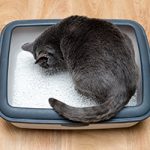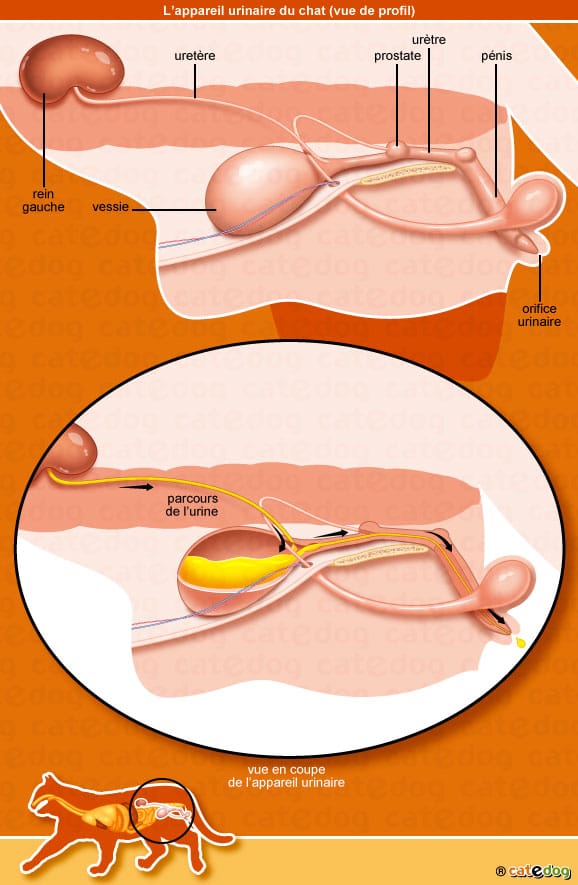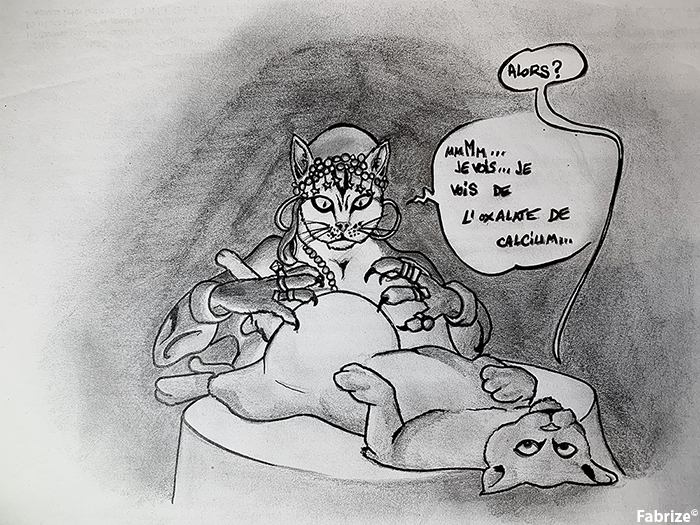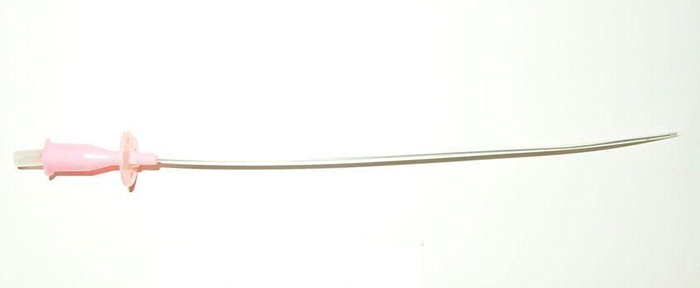
The bladder in cats
The appearance of a bladder is the result of the abnormal accumulation of urine in the bladder of an animal. Certain pathologies prevent proper urine evacuation and it sometimes even becomes completely impossible for the animal to pee.
This article will only discuss bladder emptying anomalies having an anatomical origin and not related to a dysfunction of the nerves supplying the bladder or the bladder muscles..
Some anatomical reminders
Urine eliminates various wastes (including urea) as well as minerals and water present in excess in the body. It is produced in the kidneys and then travels through two channels called ureters to the bladder where it is stored. When urinating, that is, when the animal empties its bladder, urine passes from the bladder to the outside through a conduit called the urethra.

Illustration from the site catedog.com
If something is preventing the normal passage of urine through the urethra, these accumulate in the bladder. In the male cat, the urethra is a long, narrow duct (compared to that of the female), which significantly increases the risk of obstruction.
What signs should alert you ?
Some symptoms are suggestive of urinary problems and should lead you to consult your veterinarian to check for the possible presence of a bladder.
It can be :
Urination disorders
The cat can present :
- Difficulty urinating (dysurie) : It sits in position on its litter box but emits only weak and / or jerky jets of urine or nothing at all (we are talking about anuria)
He goes on his litter very frequently and stays there for a long time - Signs of pain (strangurie) : the cat licks itself very frequently in the urogenital region and complains (meows) when he tries to pee.
- Blood in the urine (hematuria) when it manages to emit a few drops
- A tense and painful abdomen
These symptoms are unfortunately more difficult to detect for a cat who defecates outdoors.
More general symptoms
- Because of the pain, the animal has less appetite
- In more advanced cases, the cat is depressed, nausea, vomiting and anorexia
- Urine buildup in the bladder causes urea buildup, creatinine, of phosphates, potassium and hydrogen ions (which are normally eliminated during urination) in the bladder then in the blood. These substances, toxic in too high a quantity, lead to many dysfunctions such as abatement, hypothermia, a drop in the level of consciousness which can lead to a coma and cardiovascular disorders which can lead to the death of the animal.
The presence of a bladder is therefore a very serious condition which comes with a guarded prognosis. L’observation, your animal, one or more of the evocative signs mentioned above should therefore prompt you to consult a veterinarian urgently.
What are the causes of urinary retention
Lack of urine flow can have several origins in male cats
She is, in most cases, related to the presence of a physical obstacle that obstructs the urethra.
It could be :
- From a mucous plug (small clump of protein, cells and crystals which takes the form of a tube and clogs the urethra)
- Urethral stones : In cats, a change in the pH of the urine can cause the appearance of urine crystals. These can be calculations of different types : struvites or "ammonia-magnesian phosphates", oxalates de calcium, urates, cystine…
These crystals can agglomerate in stones (urolithes) which can settle in the urethra and block this narrow duct. - More rarely, of a tumor, a foreign body or stricture (narrowing of the urethral duct)

Illustration drawn by Fabrize
But the obstruction can also be the result of a functional obstruction, especially during cystitis (inflammation of the bladder). The urine flow abnormality may then be related to the presence of a urethral spasm, edema…
Diagnosis
Describing the disorders you have observed in your cat will help guide the veterinarian's diagnosis..
The latter can perform different types of examinations to confirm the presence of a urinary obstruction and look for its cause :
An abdominal palpation : to be able to see the presence of a bladder.
An abdominal ultrasound to check for the presence of stones, masses etc…
A blood test (biochemistry, ionogramme, Hematology) to check for complications caused by urinary obstruction
A cytobacteriological analysis of the urine to determine the underlying disorder, discover the nature of the crystals that may be present in the bladder (struvites or "ammonia-magnesian phosphates", oxalates de calcium, urates, cystine), check for tumor cells or the presence of bacteria.
In case of suspicion of bacterial infection, an antibiogram to choose the best antibiotic will be carried out.
Treatment
The animal is placed on a drip and then the veterinarian probes the urine under anesthesia to allow urine to flow again (by pushing back the mucous plug or any stones present) : for this, he introduces a small urinary catheter from the opening of the urethra at the end of the penis towards the interior of the bladder. During hospitalization, the cat remains on a drip in order to correct the fluid and electrolyte imbalances caused by the accumulation of urine and to fight against the shock.

Urinary catheter
To these treatments are added : analgesics, analgesics for pain relief as well as antibiotics if an initial or secondary bacterial infection after catheterization has been diagnosed. Urethral dilators can also be used. If struvite stones were found and caused the obstruction, a suitable diet will be recommended. The probe is usually held in place on average 24 to 48 hours after which it is checked that the blood tests have returned to normal and that the cat urinates normally before deciding to withdraw.
Note that in some cases, for example in the presence of calcium oxalate stones, the vet may choose to open the bladder (we are talking about cystotomy) to remove the crystals because this type of crystals cannot be eliminated by a simple change of diet.
Fight against contributing factors : prevention of recurrence
Diet influences urinary pH and the amount of minerals present in urine. If crystals have been detected by the veterinarian, he will prescribe specific foods aimed at maintaining the urine at a specific pH, opposition to the formation of all types of crystals and calculations. This feed will preferably be distributed in wet form. (swill or freshness pouches) to dilute more urine and thus promote the elimination of crystals and reduce their training.
The poor absorption of drinking water may also contribute to the onset of symptoms. The multiplication of water points (several bowls, water fountain…) will make the cat drink more.
Finally, lack of activity and overweight are, them too, factors favoring the onset of urinary disorders. The cat should therefore be encouraged to play more and regularly monitor its weight with your veterinarian..
You should know that this pathology tends to recur, and it is sometimes necessary, if recurrences are too early or too frequent, to have surgery such as a urethrostomy.
Author : Dr. Yoann Desir and illustrator : Dr. Caroline Allard – Vetup®
